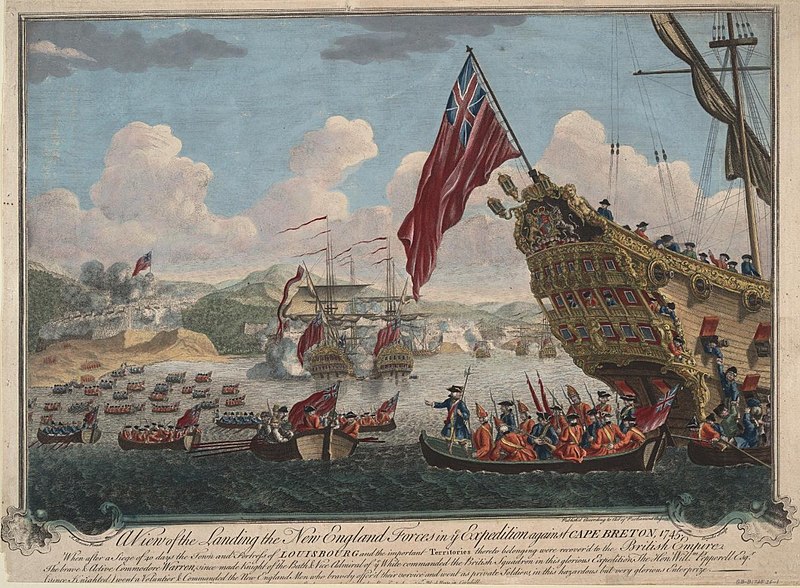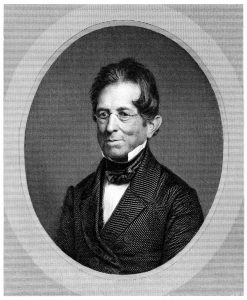By Nancy Finlay
England and France were at war during much of the 17th and 18th centuries as they raced to establish colonies in the New World. After the French King Louis XIV declared Protestantism illegal in France in 1685, many of these French Protestants, known as Huguenots, sought refuge in England and in England’s American colonies. Massachusetts, Rhode Island, and New York all received substantial numbers of Huguenot refugees. Huguenots began arriving in Connecticut in the late 1680s where Connecticut Puritans largely accepted them as fellow Protestants and the French were able to forge new lives for themselves.
Connecticut’s Role in the Wars Between England and France

Historic Acadian House in Guilford, CT used by an Acadian family following their deportation from Nova Scotia – Wikimedia Commons, Historic American Buildings Survey of Connecticut
Connecticut played an active role in the wars between England and France. Connecticut troops were stationed on the northern frontier and took part in attempts to invade Canada in 1690 and again in 1709, during Queen Anne’s War.
During King George’s War in 1745, eight Connecticut ships and 1100 men under Roger Wolcott took part in the capture of Louisbourg on Cape Breton Island. (Connecticut bitterly resented the return of Louisbourg to the French at the war’s end.) Connecticut troops also played an important part in the French and Indian War (1754-1763), participating in the capture of Fort Ticonderoga and the Battle of Quebec. In 1755, following a military victory in what is now Nova Scotia (then part of French Acadia), the English began the forced removal of the French residents, initially to the 13 English colonies, and later to Britain, France, and Spanish Louisiana. The first shipload of three hundred Acadians arrived in New London harbor on January 21, 1756.
A special assembly convened by Governor Thomas Fitch distributed these exiles among all the towns in the Connecticut Colony, handing responsibility for their wellbeing to the town selectmen. In Hartford, the selectmen had a small house built for the 13 Acadians apportioned to the city and attempted to find employment for them. In Wethersfield, Nicholas Ayrault—a descendant of an earlier Huguenot refugee, Dr. Nicholas Ayrault—was one of those placed in charge of the Acadian refugees. Unlike the earlier Huguenots, these Acadians were Roman Catholics and did not integrate easily into Puritan Connecticut. While some remained in Connecticut, many returned to their homeland following the end of the war. In 1767, Captain Richard Leffingwell sailed from New London with 240 Acadians bound for Nova Scotia.
Connecticut and France during the American Revolution
While the French had long been regarded as enemies, they became allies of the colonists during the American Revolution. Silas Deane of Wethersfield was one of the envoys to France to help negotiate the Treaty of Alliance in 1778 and recruit French officers—including the Marquis de Lafayette—to serve in the American army. The French army commanded by the Comte de Rochambeau arrived in Newport, Rhode Island, in July 1780. While most of the French army spent the winter in Newport, a detachment of French cavalry wintered in Lebanon, Connecticut.
Rochambeau and Washington met twice in Connecticut—the first time in Hartford in September 1780 and the second time in Wethersfield in May 1781. The French army left Newport in June 1781 and marched through Connecticut on its way to Yorktown, Virginia, for the battle that ultimately helped end the war. In 1824, on a tour of the United States, Lafayette—the last surviving major general from the American Revolution—made stops in Greenwich, Stamford, Norwalk, Westport, Fairfield, New Haven, Old Saybrook, Tolland, Hartford, and Middletown.
French Descendant Contributions to Connecticut
During the 19th century, the descendants of French immigrants continued to make many important contributions to Connecticut. Thomas Hopkins Gallaudet—a descendant of Pierre Elisee Gallaudet who arrived in America around 1711—graduated from Yale in 1805 and stayed to earn a master’s degree in 1808. In 1815, Gallaudet traveled to France to learn about educating deaf children and returned with a young deaf teacher named Laurent Clerc to found the first permanent school for the deaf in the United States in Hartford.
Leonard Ballou—the descendant of a French Protestant who arrived in Providence, Rhode Island, sometime prior to 1645—established a cotton mill in Killingly about 1825 in an area subsequently known as Ballouville. Charles Sigourney—a descendant of André Sigourney who arrived in Boston shortly before 1688—was one of the founders of Trinity College and the Phoenix Bank in Hartford. He is probably most famous, however, as the unsympathetic husband of the poet Lydia Huntly Sigourney.
A new influx of French-speaking immigrants began about 1850, as French Canadians poured across the border, traveling by train to find work in Connecticut’s burgeoning textile mills. In some mill towns such as Danielson, the businesses hired French-speaking clerks and doctors to cater to these new immigrants. Several French Canadian communities established their own parishes, where they conducted Mass in French. Descendants of these French Canadians include the Pulitzer Prize winning novelist Annie Proulx, who was born in Norwich.
Despite Connecticut’s image as a Puritan colony and a staunchly Yankee state, French immigrants and visitors have played a significant role in its history. From 17th-century Huguenots seeking religious freedom to French Canadian mill workers looking for jobs to immigration in its more modern forms, Connecticut has always been a place shaped, in part, by a steady French influence.
Nancy Finlay grew up in Manchester, Connecticut. She has a BA from Smith College and an MFA and PhD from Princeton University. From 1998 to 2015, she was Curator of Graphics at the Connecticut Historical Society.










